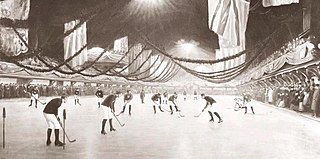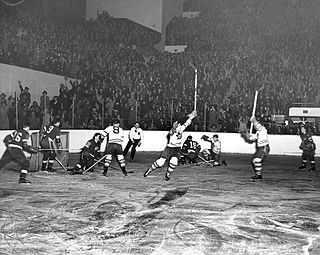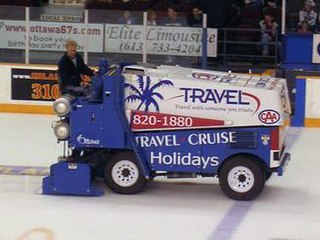 W
WIce hockey, simply referred to as hockey in both English and French in Canada, dates back to the 19th century. The sport is very popular and played year-round and at every level in the country. Born of various influences from stick-and-ball games brought from the United Kingdom and indigenous games, the contemporary sport of ice hockey originated in Montreal. It is the official national winter sport of Canada and is widely considered Canada's national pastime, with high levels of participation by children, men and women at various levels of competition.
 W
WThe collapse of the Canadian Women's Hockey League occurred in Spring 2019. Previously one of the top professional women's ice hockey leagues in the world, the Canadian Women's Hockey League (CWHL) announced on the 31 March 2019 that it would be folding on 1 May, a month later. The collapse has been one of the most significant events in 21st century hockey, and continues to have a major ongoing impact on the sport, including fuelling discussions surrounding the growth of women in hockey and the creation of the Professional Women's Hockey Players Association (PWHPA).
 W
WDee Stadium, also called The Dee, is an ice hockey arena in Houghton, Michigan, that replaced, and is located on the same site as, the Amphidrome. It is regarded as the birthplace of professional hockey, and is the seventh oldest indoor ice rink in the world.
 W
WOn March 3, 1875, the first recorded indoor ice hockey game took place at the Victoria Skating Rink in Montreal, Quebec, Canada. Organized by James Creighton, who captained one of the teams, the game was between two nine-member teams, using a wooden "puck". Members used skates and sticks used for outdoor hockey and shinny games in Nova Scotia, where Creighton was born and raised. It is recognized as the first organized ice hockey game.
 W
WA Great Game: The Forgotten Leafs and the Rise of Professional Hockey is a 2013 non-fiction book by Stephen Harper concerning the history of professional ice hockey in Canada during the early 20th century.
 W
WThe three forwards – the centre, right wing and left wing – operate as a unit called a line. The tradition of naming the threesomes who compose the hockey teams' lines of attack extends back to the inaugural 1917–18 NHL season, when Didier Pitre, Jack Laviolette, and Newsy Lalonde of the Montreal Canadiens were dubbed the "Flying Frenchmen Line".
 W
WThe Miracle in Espoo, known in Finnish as Ihme Espoossa, was the 2019 IIHF Women's World Championship semifinal game played on 13 April 2019, at Espoo Metro Areena in Espoo, Finland, between Canada and hosts Finland. It is considered one of the biggest upsets in women's ice hockey history.
 W
WThe history of the National Hockey League begins with the end of its predecessor league, the National Hockey Association (NHA), in 1917. After unsuccessfully attempting to resolve disputes with Eddie Livingstone, owner of the Toronto Blueshirts, executives of the three other NHA franchises suspended the NHA, and formed the National Hockey League (NHL), replacing the Livingstone team with a temporary team in Toronto, the Arenas. The NHL's first quarter-century saw the league compete against two rival major leagues—the Pacific Coast Hockey Association and Western Canada Hockey League—for players and the Stanley Cup. The NHL first expanded into the United States in 1924 with the founding of the Boston Bruins, and by 1926 consisted of ten teams in Ontario, Quebec, the Great Lakes region, and the Northeastern United States. At the same time, the NHL emerged as the only major league and the sole competitor for the Stanley Cup; in 1947, the NHL completed a deal with the Stanley Cup trustees to gain full control of the Cup. The NHL's footprint spread across Canada as Foster Hewitt's radio broadcasts were heard coast-to-coast starting in 1933.
 W
WThe Original Hockey Hall of Fame, formerly the International Hockey Hall of Fame (IHHOF) is a museum dedicated to the history of ice hockey in Canada, located in Kingston, Ontario, Canada. The IHHOF was intended to be the original Hall of Fame for hockey, but events led to the establishment of the Hockey Hall of Fame in Toronto, Ontario instead. The IHHOF hosted exhibits for the International Ice Hockey Federation (IIHF) from 1992 to 1997, prior to the establishment of the IIHF Hall of Fame. The IHHOF was renamed the Original Hockey Hall of Fame in 2013, and now focuses on the history of the sport, and emphasis on the role people from Kingston had in its development.
 W
WPlaying hockey games outdoors—in soccer, football and baseball stadiums—is an increasingly popular trend for junior, college, professional and international competitions in the 21st century. The popularity of outdoor games has resulted in attendance records in several leagues, and the current world record total of 104,173 was set at The Big Chill at the Big House, a December 2010 National Collegiate Athletic Association game between the University of Michigan and Michigan State University.
 W
Wice hockey in Scotland is the most popular indoor sport in Scotland, with a fairly established presence in each of the population centres and a spectator attendance lower only to football and rugby union. The term "hockey" is usually reserved for field hockey in Scotland, and "ice hockey" is normally referred to by its full form.
 W
WThe teddy bear toss is a popular Christmas season promotion most common at junior ice hockey and minor league hockey games. Fans are encouraged to bring teddy bears or other stuffed toys to the game, and to throw them onto the ice when the home team scores its first goal. The toys are gathered up to be donated as presents to hospitals and charities. In many cases, the players themselves personally donate some of the bears to children at area hospitals. The Hershey Bears claim a world record of 45,650 stuffed toys in a single game.
 W
WIce hockey, usually referred to in the U.S. simply as "hockey", is a popular sport in the United States. Hockey in the U.S. began in 1894 when the first artificial ice rink was built in Baltimore, Maryland. Now hockey is most popular in regions of the U.S. with cold winter climates, such as the northeast and the upper Midwest. However, since the 1990s, ice hockey has become increasingly popular in the Sun Belt due in large part to the expansion of the National Hockey League to the southeast and southwest U.S., coupled with the mass relocation of many residents from northern cities with strong hockey support to these Sun Belt locations.
 W
WThe first instances of organized women's ice hockey in Canada date back to the 1890s when it was played at the university level. The Women's Hockey Association claims that the city of Ottawa, Ontario hosted the first game in 1891. In 1920, Lady Meredith, wife of Sir Vincent Meredith of Montreal donated the Lady Meredith Cup to the Quebec Ladies' Hockey Association, said to be the first women's ice hockey trophy to be competed for in Canada. In February 1921 a women's international championship series was played in conjunction with the Pacific Coast Hockey Association. One of the first professional teams were the Vancouver Amazons from the 1920s. They were the first women's hockey team from Vancouver to participate in the invitational women's hockey tournament sponsored by the Banff Winter Carnival. On December 16, 1922, a meeting was held to announce the formation of the Ladies Ontario Hockey Association. The Dominion Women's Amateur Hockey Association was founded in winter 1933. Lady Bessborough, the wife of Governor General of Canada Lord Bessborough donated a championship trophy.
 W
WThe history of women's ice hockey in the United States can be traced back to the early 20th century. In the 1920s, the Seattle Vamps competed in various hockey tournaments. In 1916, the United States hosted an international hockey tournament in Cleveland, Ohio, that featured Canadian and American women's hockey teams.
 W
W"Zamboni", also known as "I Wanna Drive the Zamboni", is a song written by Martin Zellar and recorded by his band Gear Daddies. The song tells the story of a man's desire to drive an ice resurfacer, popularly known by the brand name "Zamboni", and his request to drive the Zamboni for his local ice hockey team. Since its release, it has sometimes been played between periods at hockey games while the Zamboni cleans the ice.